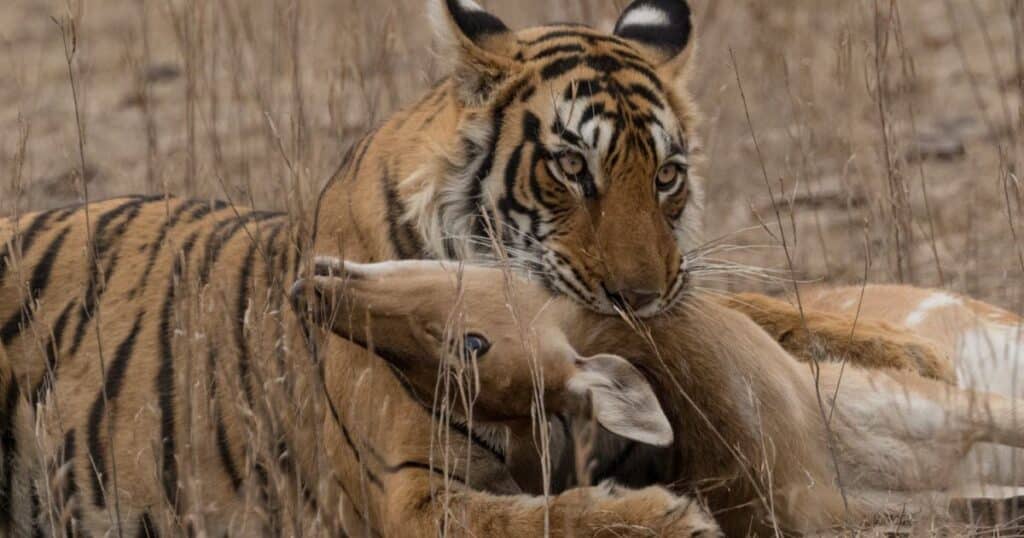It is no secret that deer perceive the world differently because of the unique limitations of their vision. After all, hunters wearing bright orange can be almost invisible to deer. Knowing this, you can’t help but wonder: in Asia, how do deer see tigers? Aren’t deer able to see these orange apex predators?
Today, we are going to discuss everything there is to know about deer vision, how it works, and what other adaptive features and senses deer have developed to aid them in their survival.
How Do Deer Perceive the World?
To say that deer have unique visual abilities is an understatement.
Between the limited field of view, color vision, and overall structure and function of their eyes, there’s a lot to understand in order to fully understand exactly how deer are able to perceive the world, including how they see tigers.
Deer Vision – Field of View
Deer have a wider field of view because of how their eyes are positioned on the sides of their head. This gives them panoramic vision.
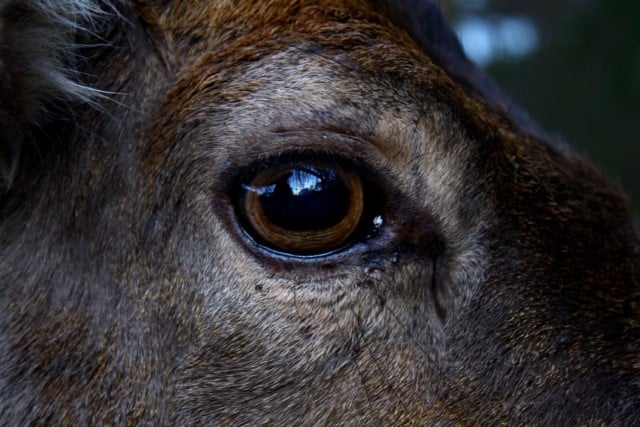
This allows them to be able to monitor a larger area without having to physically move their heads.
While this allows for wider vision, this makes them have a much more limited depth perception. This makes it harder for them to see what is directly in front of them.
Deer Eye Structure
Deer have a unique eye structure with adaptations that help these animals better survive in the wild.
Some of the useful features of deer eyes include wide pupils, tapetum lucidum, and low-light vision that allows for better vision in the dark.
Wide Pupils
Deer eyes have wider pupils than what we see in other animals. Their pupils can dilate to allow more light into their eyes.
This is especially helpful in low-light conditions and helps deer adapt to darker environments, enhancing their night vision.
Tapetum Lucidum
The tapetum lucidum is a thin layer of tissue in the eyeball located behind the retina to reflect light back through it. This allows the eyeballs a chance to detect and process light, enhancing low light vision.
That is the reason you may see the “eye shine” of a deer’s eyeball when it is dark and there is light shined in the eyes.
High Functioning Retina
Deer have excellent low-light vision due to a high number of rod cells in the retina which make their vision clearer in low light settings. This allows these animals to be most active from dusk to dawn, as their eyes are well adapted.
How Do Tigers Appear to Deer?
Now that we have gone over the visual capabilities of deer, it is natural to ask how they are able to survive and protect themselves from their predators. Today, we’re learning specifically about how they perceive tigers.
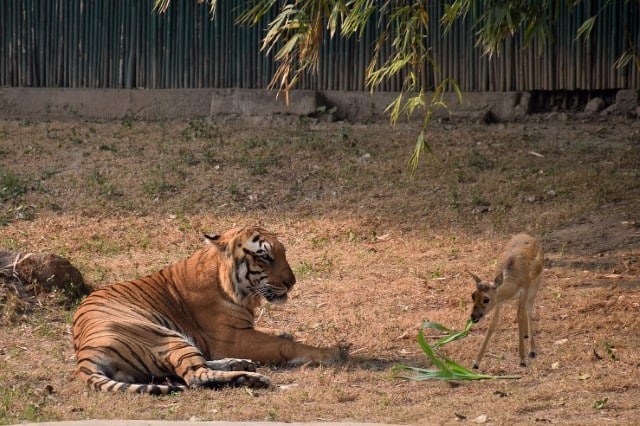
It is important to note that tigers have evolved in both their physical characteristics and behavioral strategies when it comes to hunting their prey.
However, deer do have some limitations that make it easier for tigers to hunt them.
Below we’ll talk about the factors we need to think about when it comes to deer and how they see (and whether they can escape from) tigers.
Camouflage
One reason deer may have difficulty clearly seeing tigers is their limited depth perception paired with how tigers camouflage themselves.
The tiger’s stripes break up the tiger’s image, which helps them blend into their natural habitats including tall grass, dense forest, and rocky terrain. As a result, they’re more difficult for other animals (such as deer) to detect.
Fear Factor
Deer have a natural instinct and reflex response to fear which helps them avoid predators.
The sight of a tiger or other predator can trigger a strong fear response.
While they might not always see them right away, seeing a tiger nearby will trigger the response to flee in deer.
Crepuscular vs Nocturnal
As crepuscular creatures, deer are most active around dawn and dusk. Also, they may often be active during full daylight, too.
By contrast, tigers are nocturnal and most active at night, but they also enjoy hunting during the dawn and dusk times when deer are likely to be active.
This means that there is a strong likelihood that if a deer lives in an area of the world where there are tigers, they may encounter a tiger in those times of the day.
Unfortunately (for the deer), dawn and dusk are the times of day when they’ll have the most trouble seeing tigers in time to escape.
Habitat
Habitats play a significant role in how deer perceive their environments and potential threats, including tigers. Remember that the tiger’s stripes help to camouflage them.
In open areas, a tiger may be much more visible to a deer than it would be in areas with dense vegetation.
That is why tigers prefer to stalk and hunt their prey in forested areas, as it’s easier for them to hide and pounce without warning.
However, one disadvantage of forested areas for the tiger is how their movement can create noise that deer will quickly hear and be alerted by.
Factors Influencing Deer Perception of Tigers
A deer’s perception of a tiger is affected by the primary factors such as camouflage, reflex, and activity patterns. But there are additional factors that may have an impact, too.
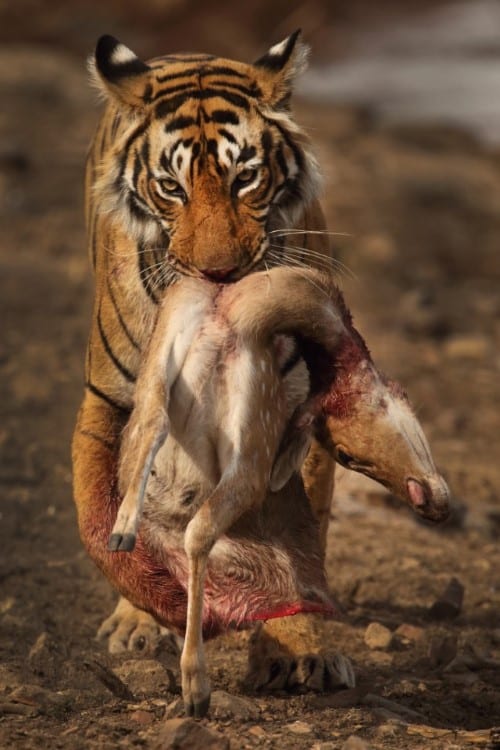
These include scent, auditory sensitivity, habitat, and overall cervid (deer) psychology.
Scent Detection
While deer have a limited sense of vision, they have an excellent sense of smell that allows them to perceive the scent of tigers through things like pheromones and urine markings.
If a deer detects a tiger’s scent, this can dramatically trigger its alertness and awareness of danger, making them much more likely to flee.
Auditory Sensitivity
Deer also have keen hearing and are able to pick up on sounds quickly.
Things like rustling in bushes, snapping of twigs or even the growls, roars, and general sounds associated with tigers are easily heard by deer.
Psychology
Understanding deer psychology is integral to developing insight into their behaviors.
Learned Behaviors
Similar to humans, deer are able to learn from past experiences.
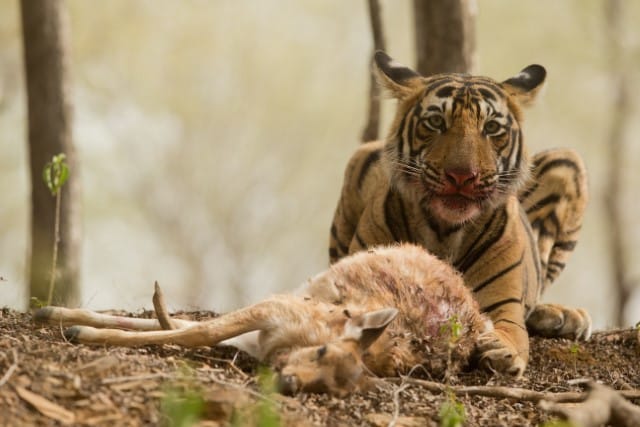
Previous encounters with tigers or similar predators can sharpen a deer’s awareness and abilities, leading it to be more cautious in case of another encounter.
From their experiences, deer are able to pick up more on cues that indicate danger and even sharpen up on their abilities to flee.
Cognitive Adaptation
Deer are especially flexible in adapting to their environment in accordance with their experiences.
They are able to adjust aspects of their behavior such as activity patterns, feeding behavior and how they move in order to minimize threats and improve their chance of survival.
Group Behaviors
Similarly, deer are able to gather with one another and give cues or warning signals that aid in their survival.
Deer are able to communicate with one another through use of vocalizations and body language.
If an individual deer has had a past encounter with a tiger, it warns the others in the face of danger. The psychology behind group behaviors in deer is essential to their perception and survival.
Implications for Wildlife Conservation
While the study of the relationship between deer and tigers is fascinating in itself, there are practical reasons for conversationists to study it.
Understanding this relationship is essential when it comes to factors regarding wildlife conservation when it comes to things like ecosystem health, anti-poaching measures, and of course, research.
Ecosystem
The relationship between deer and tigers is the relationship between a prey animal and predator.
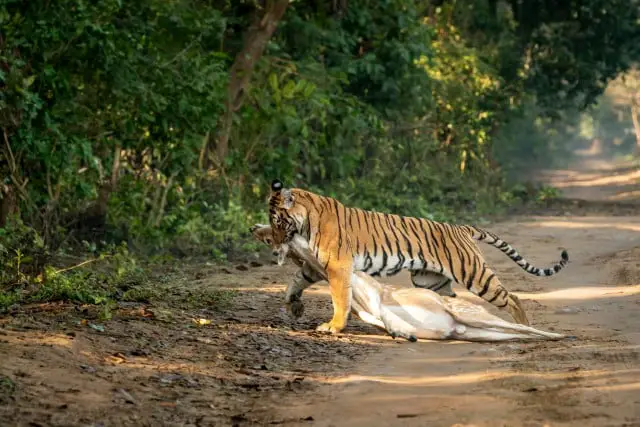
This relationship is a fundamental aspect of ecosystem dynamics. Healthy ecosystems require a healthy population of both predators and prey, so that problems such as overpopulation are prevented. This is important, as deer overpopulation leads to depletion of natural resources in their ecosystems.
By understanding aspects of the predator-prey relationship, such as the way deer perceive tigers, lets experts better manage and protect ecosystems.
Anti-Poaching
While there is an obvious predator-prey relationship between tiger and deer, deer are actually helpful to tigers in acting as an indicator species. These are species that are used to monitor the health and condition of the environment.
By taking cues from deer, conservationists are able to further study the behavior and tendencies of tigers for better conservation efforts and in enforcing anti-poaching measures.
These can include programs and training such as educational programs, habitat restoration, enhanced surveillance, and an increased overall community effort to conserve wildlife particularly in both deer and tigers.
Research
Of course, observing the relationship between deer and tigers in the wild creates valuable research opportunities that help build insight into the health and dynamics of the ecosystem as a whole.
Studying behaviors and behavioral changes are key in conducting research that aids in the creation of long-term conservation strategies.
Final Thoughts: How Deer See Tigers
There is still some uncertainty about exactly how deer see and perceive tigers.
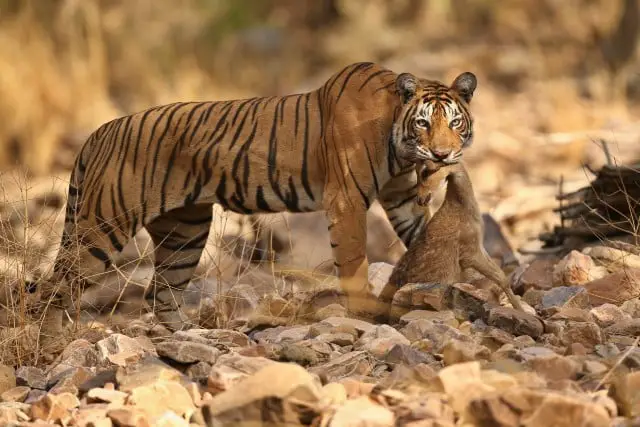
By understanding the various factors that affect the everyday behaviors of deer in an environmental context, such as their sensory perception, learned behaviors, and habitats, we are able to make informed predictions about how they may perceive tigers.
Having as much information as possible on how deer perceive tigers is useful in practical applications for wildlife conservation and research.
Observing the behavior of deer both individually and in a group in terms of how they react to their predators, as well as their adaptive skills, will help us better understand the adaptations of tigers that allow them to successfully hunt prey.
As deer and tigers are in a prey-predator relationship, we need to understand this relationship and how it plays an integral role in conservation efforts and protecting ecosystems.

